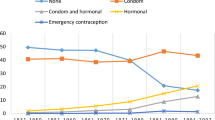Abstract
Fertility regulation and prevention of sexually transmitted diseases (STDs) are recognized pillars in fertility health work. The HIV epidemic has made it clear that there are people at risk for STDs all over the world. Both STDs and unwanted pregnancies are negative consequences of the same behavior, i.e., unprotected intercourse. From the perspective of the individual the risks with unprotected intercourse vary over time and with actual life-style. To meet the needs of the individuals the concept of contraceptive counselling needs to be expanded. Clinics where gynecologists and midwives join forces together with venerologists and social workers are being developed in Sweden. The goal for the clinics is to give an integrated message on STD and pregnancy protection.
Resumé
La régulation de la fécondité et la prévention des maladies sexuellement transmissibles (MST) sont des piliers reconnus des travaux dans le domaine de la santé concernant la fécondité. L'épidémie de HIV a mis en évidence que les risques de contracter des maladies sexuellement transmissibles existent à l'échelle mondiale. Aussi bien ces maladies que les grossesses non désirées sont des conséquences néqatives du même comportement, à savoir les rapports sexuels non protégés. Au niveau de l'individu, les risques que présentent ces rapports varient avec le passage du temps et en fonction du style de vie. Afin de répondre aux besoins de l'individu, la notion de conseil en matière de contraception doit être élargie. En Suède, les cliniques où des gynécologues et des sages-femmes travaillent côte à côte avec des vénérologues et des assistants sociaux se multiplient. L'objectif de ces cliniques est de faire passer un message intégré portant sur les maladies sexuellement transmissibles et la prévention des grossesses.
Resumen
La regulación de la fecundidad y la prevención de las enfermedades sexualmente transmisibles (EST) son los pilares reconocidos del trabajo en el terreno de la salud aplicada a la fecundidad. La epidemia de HIV puso de relieve que los peligros de contraer enfermedades sexualmente transmisibles existen a escala mundial. Tanto estas enfermedades como los embarazos no deseados son la consecuencia negativa del mismo comportamiento, es decir, las relaciones sexuales no protegidas. A nivel de la persona, los riesgos que presentan estas relaciones varían con el correr del tiempo y según el estilo de vida. A fin de responder a las necesidades de la persona, debe ampliarse el concepto de asesoramiento en materia de anticoncepción. En Suecia, las clínicas donde los ginecólogos y las parteras trabajan juntamente con venereólogos y asistentes sociales están aumentando. El objetivo de estas clínicas es transmitir un mensaje integrado sobre las enfermedades sexualmente transmisibles y la prevención del embarzzo.
Similar content being viewed by others
References
World Health Organization (1990).Research in Human Reproduction, Biennial Report 1988–1989. WHO, Geneva, Switzerland
AdlerM.W. (1990). The epidemiology of sexually transmitted diseases in the west.Semin. Dermatol.,9, 96–101
HeymanD.L., ChinJ. and MannJ.M. (1990). A global overview of AIDS. In: AlexanderN.J., GabelnickH.L. and SpielerJ.M. (eds.)Heterosexual Transmission of AIDS. Wiley-Liss, New York, pp 1–8
world Health Organization Collaborating Centre for Sexually Transmitted Diseases and their Complications (1989).Guidelines for the Prevention of Genital Chalamydial Infections, University of Uppsala, Sweden
AnagriusC., HallenA., MoiH. and PerssonE. (1990). Prevention of sexually transmitted disease and abortions—the present situation for medical care of sexually transmitted diseases in Sweden.Semin. Dermatol.,9, 190–193
National Bacteriological Laboratory (1990).Statistics 1989. Stockholm, Sweden
National Board of Health and Welfare (1990).Chlamydial Infections. Allmänna Förlaget, Stockholm, Sweden
JaribroG. and PerssonE. (1990). Ungdomar vet mycket om STD och preventivmetoder. (Young people know much about STD and contraception but have problems practising it.) (In Swedish)Läkartidningen,87, 4296–4298
LouvW.C., AustinH., AlexanderW.J., StaguoS. and CheeksJ. (1988). A clinical trial of nonoxynol-9 for preventing gonococcal and chlamydial infections.J. Infect. Dis..158, 518–523
PerssonE. and Beckman-NahmiasS. (1990). Contraception, number of partners and STDs among Swedish women. In: Job-SpiraN., SpencerB., MoattiJ.P. and BouvetE. (eds.)Public Health and the Sexual Transmission of Diseases. John Libbey, Paris, London, pp. 333–337
RiphagenF.E. and vonSchoultzB. (1989). Contraception in SwedenContraception,39, 633–641
Author information
Authors and Affiliations
Additional information
This paper is based on a presentation given at the Seventh International Meeting of the Society for the Advancement of Contraception, which was held in Singapore on 4–11 November, 1990.
Rights and permissions
About this article
Cite this article
Persson, E. Family planning and prevention strategies for sexually transmitted diseases. Adv Contracept 7, 181–186 (1991). https://doi.org/10.1007/BF01849408
Issue Date:
DOI: https://doi.org/10.1007/BF01849408




